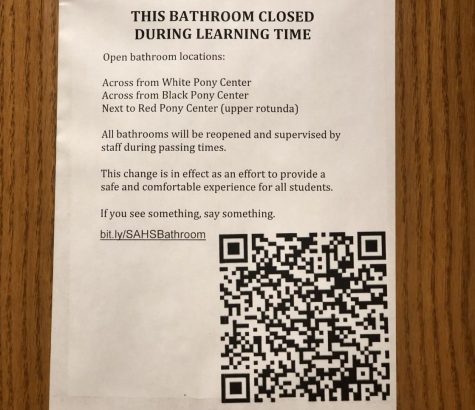Snapchat rising above old-school text messaging

As social media continues to pervade every element of day-to-day life, ‘older’ ways of communicating seem to lose popularity among the current generation. This allows for more exploration of newer interfaces, which seem to be constantly updating how people share their life with the world.
One of the most prevalent leaders in direct social media communication is Snapchat, the interface that allows users to tie a facial expression to the message that they are either sending or receiving, assisting in less misinterpretations. Since Snapchat’s official release in Sept. of 2011 by its founders whom were students of Stanford University, Evan Spiegel, Bobby Murphy, and Reggie Brown, Snapchat has seen a 67 percent increase in usage, as compared to texting, which has begun to flat line in its usage statistics at a 22 percent increase since 2007.
A Fun New Way to Communicate
“[Snapchat] is a way to switch things up. Instead of paragraphs, you can send short clips and then you can never see them again,” junior Maddie Harrington said.
The app is a more interactive way of communicating for users because of its multiple features such as filters for weather, time, speed, battery and color, along with messaging, geofilters, and interactive filters that can make the user into an animated character.
Sophomore Jane Hubbard said, “I like the new features, they are funny and fun to use.”
Snapchat was started by Brown and Spiegel for a Stanford University project that was required in one of Spiegel’s classes. Initially released in July 2011 under the name Picaboo, Snapchat has undergone numerous updates (including the obvious name change), the most recent being the animated filters, some now being offered as an in-app purchase.
Harrington said, “I am not exactly sure how I feel about the filters. They’re cool, but completely useless so I think they should be in-app purchases.”
Older Means of Communication Are Still Useful
On the flip side, texting has been very basic since the first text sent by Niel Papworth on Dec. 3, 1992 off of a computer to an Orbital 901 Handset. Texting itself is unable to be updated, but the technologies that display the messages have come very far, from a handset to the iPhones and Androids of the world, which contain more intelligence than the first satellite to outer space did.
Texting is less interactive because you can’t sense tones. Snapchat makes it easier to sense sarcasm and emotion through facial expressions.
— Maddie Harrington
Social media interfaces may allow for more entertaining and interesting conversations, but they are not as formal as a text, phone call or email.
Junior Lindy Einan said,”Snapchat cannot replace texting or email. It [Snapchat] is too informal and sending long messages on it is difficult.”
Even though texting, emailing, and phone calling is needed for more formal and personal reasons, that does not take away from the fact that social media is a great way to enjoy communicating to others and share excerpts of one’s life to many friends.
“I think the main reason social media is so important to us teenagers is we can all be connected without having to actually be in the same room as them. Plus, we grew up with it, so we don’t know what it is like for it to not exist.” added Hubbard.
A Threat to Personal Information
Although forms of social medias such as Snapchat are a seemingly harmless way to share information, the more digitized the world becomes, the bigger the threat hacking becomes to be.
As of 2014, Snapchat faced a major hacking, which exposed the accounts of 4.6 million interface users, on the website titled SnapchatDB.info, which has since been suspended. Since then, the technicians behind the updates have not placed security as a secondhand measure, and require more information such as a phone number, to create an account. Snapchat continuously updates their users on issues such as abuse and leakages, along with new features and future updates on their blog.
Texting faces similar threats, as with the correct code, a hacker can begin to eat away at all stored data within the phone, and although rare, it is a threat. Companies such as Apple and Android update their systems and software with every new release, slimming the chances of a code affecting the phone’s information storage.
Harrington said, “I don’t think people should be worried about hacking because why would anyone want to steal a Snapchat?”
Snapchat is rising over texting among the newer generation and becoming increasingly more enjoyable and interactive for snapchatters. As phones increase in intelligence, texting becomes a more formal and less enjoyable for users who seek to expend the features that their new device is capable of.
“Texting is less interactive because you can’t sense tones. Snapchat makes it easier to sense sarcasm and emotion through facial expressions.” Harrington added.

Tiana Meador is a senior at SAHS and one of the online Editor-in-Chiefs. She enjoys being outdoors, painting, snowboarding, and surrounding herself with...



















Sam Hudachek • Jan 7, 2016 at 9:03 am
This was a great article! I loved how you put the origins of both Snapchat and texting in there. I also love the infograph and the information that was put in it!
Liv Krusinski • Jan 7, 2016 at 3:39 am
I love your vocabulary through out the article. It gave a good amount of background info and some great quotes. It’s interesting to see peoples opinions on this topic. The only thing I’d say is that the font is pretty small on the infographic, so there might be too much information. Overall it was well done.
Austin Dowdall • Jan 6, 2016 at 11:01 pm
This article was an easy read, I enjoyed it, it was very well written and had great quotes.
Brian Jaap • Jan 6, 2016 at 10:16 pm
This article was extremely well written and to the point. Your quotes were very relevant and powerful! I really enjoyes reading this not only because it was interesting to see the views of different people on this subject, but to see the statistics of everything. Awesome infographic also.
Hannah Anderson • Jan 6, 2016 at 7:51 pm
I really enjoyed reading this article, not only because it’s about snapchat which is interesting itself, but because of how well written it was. It included a lot of detail explaining the use of snapchat versus text messaging as well as quotes from students at Stillwater about their views on the two ways of socializing and communicating. I also thought it was very informative in addition to entertaining because of the background information on how snapchat and text messaging began and the great infographic.
Kaitlyn Wylie • Jan 6, 2016 at 7:46 pm
This was a very interesting topic I think you did a great job! It was nice to see both sides of the story, and what people prefer. It was really interesting and you had a bunch of information from both sides of the views which was a big plus.
Jared Dean • Jan 6, 2016 at 6:41 pm
Very well written! I really enjoyed reading this article! It was interesting to see how things like Snapchat and texting got their starts. Your quotes were very well placed and provided a nice insider’s opinion! I also really liked your use of emojis in the infographic!
Erin Lemanski • Jan 6, 2016 at 1:36 pm
Great story Tiana! Your story was very interesting to me. I liked your use of diction throughout the article. I also thought it was wise that you gave a lot of background information on the topic. Lastly I thought your ending quote was very strong. Nicely done!